airbag PEUGEOT 5008 2012 Owners Manual
[x] Cancel search | Manufacturer: PEUGEOT, Model Year: 2012, Model line: 5008, Model: PEUGEOT 5008 2012Pages: 340, PDF Size: 16.42 MB
Page 4 of 340
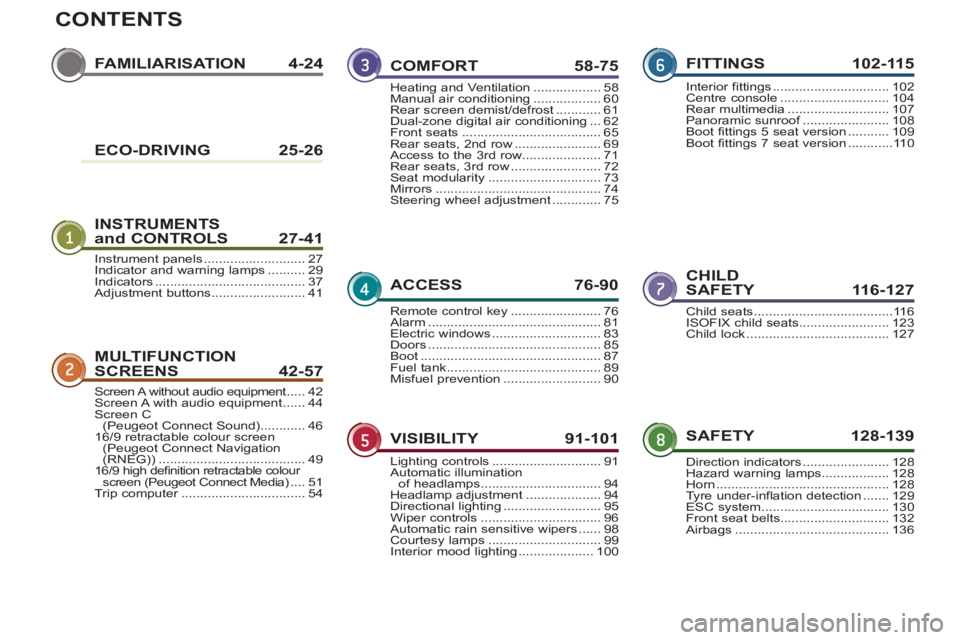
CONTENTS
FAMILIARISATION4-24
INSTRUMENTSand CONTROLS 27-41
CHILDSAFETY 116-127
MULTIFUNCTION
SCREEN
S42-57
SAFETY 128-139
COMFORT 58-75
ACCESS 76-90
VISIBILITY 91-101
FITTINGS 102-115
Instrument panels ...........................27Indicator and warning lamps ..........29Indicators........................................37Adjustment buttons.........................41
Child seats.....................................116ISOFIX child seats........................123Child lock......................................127
Screen A without audio equipment.....t42Screen A with audio equipment......44Screen C (Peugeot Connect Sound)............4616/9 retractable colour screen(Peugeot Connect Navigation (RNEG)) .......................................4916/9 high definition retractable colour screen (Peugeot Connect Media)....51Trip computer.................................r54
Direction indicators.......................128Hazard warning lamps..................128Horn..............................................128Tyre under-inflation detection .......129ESC system..................................130Front seat belts.............................132Airbags .........................................136
Heating and Ventilation ..................58Manual air conditioning ..................60Rear screen demist/defrost............61Dual-zone digital air conditioning...62Front seats.....................................65Rear seats, 2nd row.......................69Access to the 3rd row.....................71Rear seats, 3rd row........................72Seat modularity..............................73Mirrors............................................74Steering wheel adjustment .............75
Remote control key........................76Alarm..............................................81Electric windows.............................83Doors ..............................................85Boot................................................87Fuel tank.........................................89Misfuel prevention..........................90
Lighting controls.............................91Automatic illumination
of headlamps................................94Headlamp adjustment ....................94Directional lighting ..........................95Wiper controls................................96Automatic rain sensitive wipers......98Courtesy lamps ..............................99Interior mood lighting ....................100
Interior fittings ...............................102Centre console .............................104Rear multimedia...........................107Panoramic sunroof.......................f108Boot fittings 5 seat version ...........109Boot fittings 7 seat version ............110ECO-DRIVING 25-26
Page 11 of 340
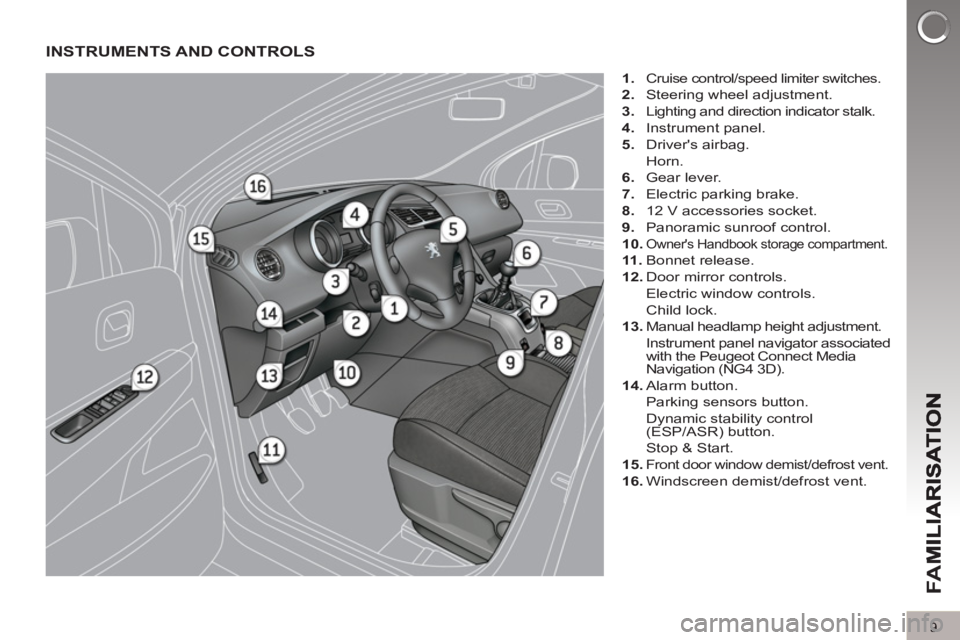
FA
M
9
INSTRUMENTS AND CONTROLS
1.
Cruise control/speed limiter switches.
2.
Steering wheel adjustment.
3.
Lighting and direction indicator stalk.
4.
Instrument panel.
5.
Driver's airbag.
Horn.
6.
Gear lever.
7.
Electric parking brake.
8.
12 V accessories socket.
9.
Panoramic sunroof control.
10.
Owner's Handbook storage compartment.
11 .
Bonnet release.
12.
Door mirror controls.
Electric window controls.
Child lock.
13.
Manual headlamp height adjustment.
Instrument panel navigator associated
with the Peugeot Connect Media
Navigation (NG4 3D).
14.
Alarm button.
Parking sensors button.
Dynamic stability control
(ESP/ASR) button.
Stop & Start.
15.
Front door window demist/defrost vent.
16.
Windscreen demist/defrost vent.
Page 12 of 340
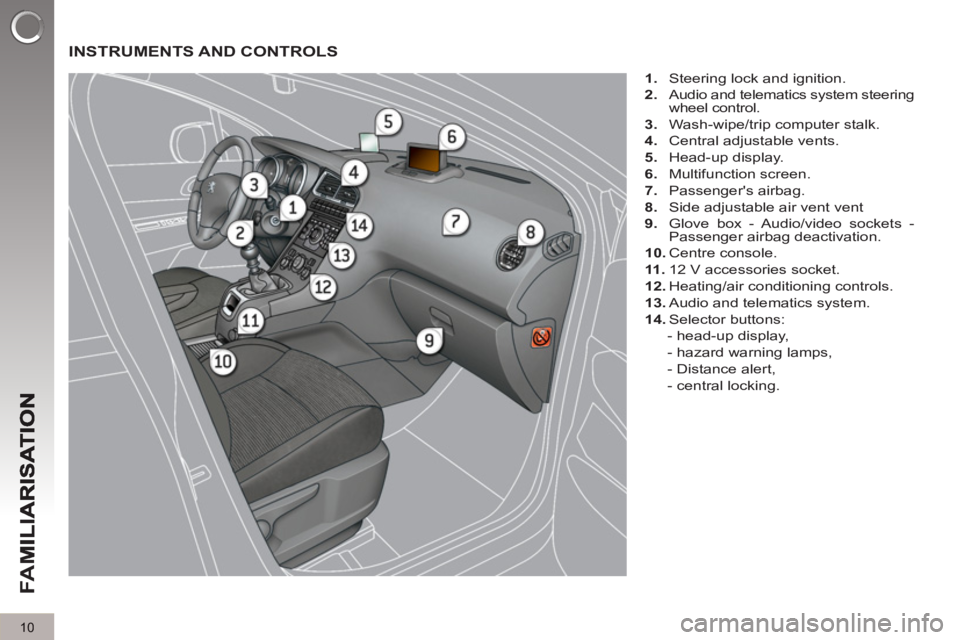
FA
M
10
INSTRUMENTS AND CONTROLS
1.
Steering lock and ignition.
2.
Audio and telematics system steering
wheel control.
3.
Wash-wipe/trip computer stalk.
4.
Central adjustable vents.
5.
Head-up display.
6.
Multifunction screen.
7.
Passenger's airbag.
8.
Side adjustable air vent vent
9.
Glove box - Audio/video sockets -
Passenger airbag deactivation.
10.
Centre console.
11 .
12 V accessories socket.
12.
Heating/air conditioning controls.
13.
Audio and telematics system.
14.
Selector buttons:
- head-up display,
- hazard warning lamps,
- Distance alert,
- central locking.
Page 19 of 340
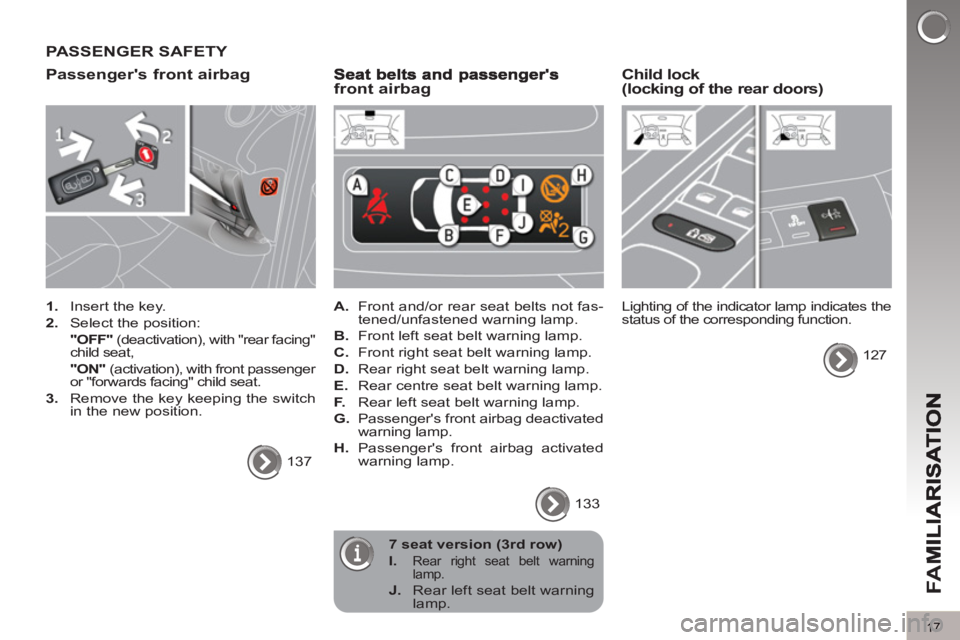
FA
M
17
PASSENGER SAFETY
Passen
ger's front airbag
1.
Insert the key.
2.
Select the position:
"OFF"
(deactivation), with "rear facing"
child seat,
"ON"
(activation), with front passenger
or "forwards facing" child seat.
3.
Remove the key keeping the switch
in the new position.
137
front airbag
A.
Front and/or rear seat belts not fas-
tened/unfastened warning lamp.
B.
Front left seat belt warning lamp.
C.
Front right seat belt warning lamp.
D.
Rear right seat belt warning lamp.
E.
Rear centre seat belt warning lamp.
F.
Rear left seat belt warning lamp.
G.
Passenger's front airbag deactivated
warning lamp.
H.
Passenger's front airbag activated
warning lamp.
133
Child lock (locking of the rear doors)
Lighting of the indicator lamp indicates the
status of the corresponding function.
127
7 seat version (3rd row)
I.
Rear right seat belt warning
lamp.
J.
Rear left seat belt warning
lamp.
Page 34 of 340
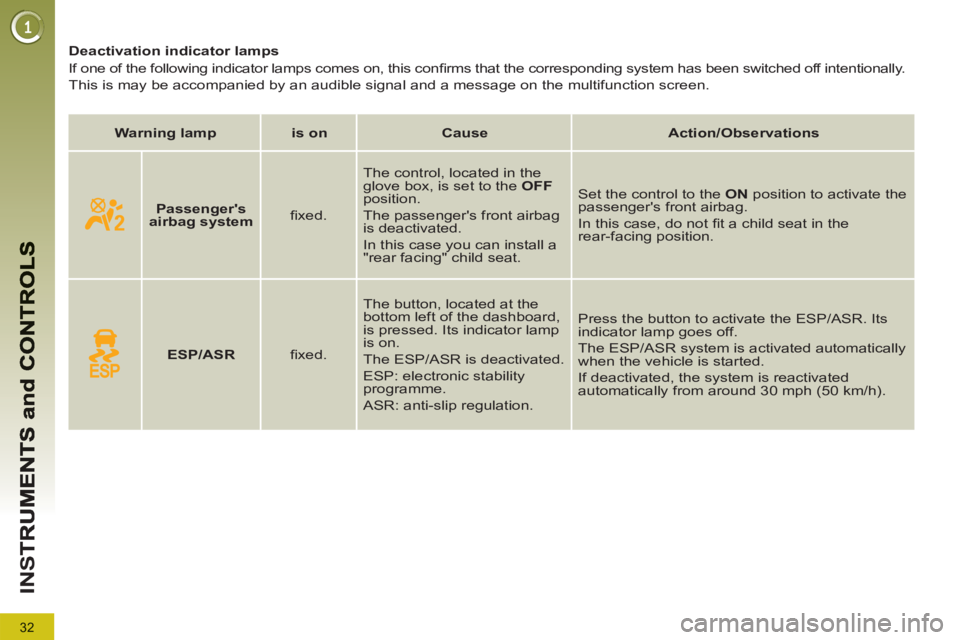
32
IN
S
Deactivation indicator lamps
If one of the following indicator lamps comes on, this confi rms that the corresponding system has been switched off intentionally.
This is may be accompanied by an audible signal and a message on the multifunction screen.
Warning lamp
is on
Cause
Action/Observations
Passenger's
airbag system
fi xed. The control, located in the
glove box, is set to the OFF
position.
The passenger's front airbag
is deactivated.
In this case you can install a
"rear facing" child seat. Set the control to the ON
position to activate the
passenger's front airbag.
In this case, do not fi t a child seat in the
rear-facing position.
ESP/ASR
fi xed. The button, located at the
bottom left of the dashboard,
is pressed. Its indicator lamp
is on.
The ESP/ASR is deactivated.
ESP: electronic stability
programme.
ASR: anti-slip regulation. Press the button to activate the ESP/ASR. Its
indicator lamp goes off.
The ESP/ASR system is activated automatically
when the vehicle is started.
If deactivated, the system is reactivated
automatically from around 30 mph (50 km/h).
Page 38 of 340
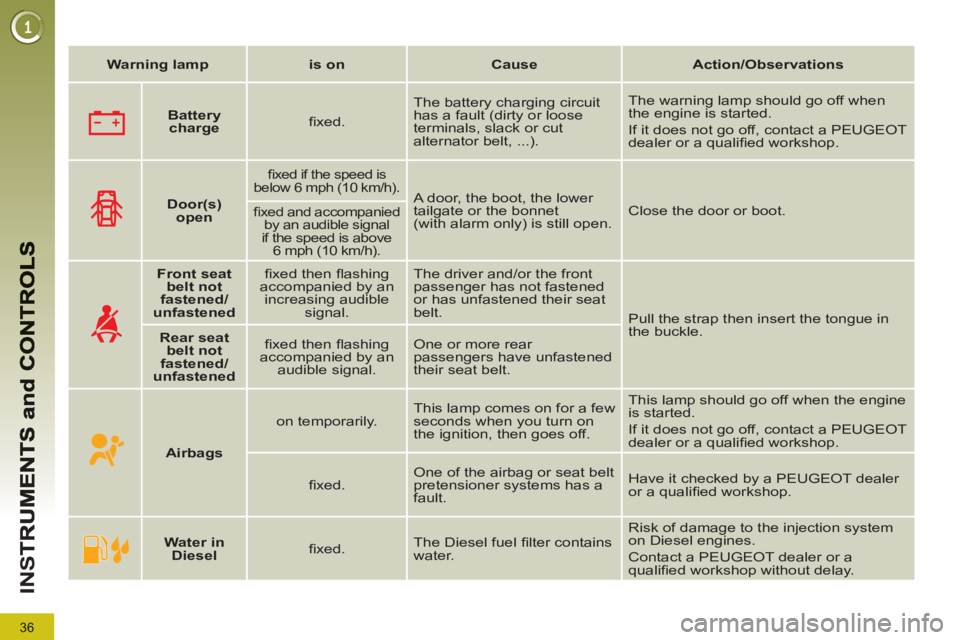
36
IN
S
Battery
charge
fi xed. The battery charging circuit
has a fault (dirty or loose
terminals, slack or cut
alternator belt, ...). The warning lamp should go off when
the engine is started.
If it does not go off, contact a PEUGEOT
dealer or a qualifi ed workshop.
Warning lamp
is on
Cause
Action/Observations
Front seat
belt not
fastened/
unfastened
fi xed then fl ashing
accompanied by an
increasing audible
signal. The driver and/or the front
passenger has not fastened
or has unfastened their seat
belt.
Pull the strap then insert the tongue in
the buckle.
Rear seat
belt not
fastened/
unfastened
fi xed then fl ashing
accompanied by an
audible signal. One or more rear
passengers have unfastened
their seat belt.
Door(s)
open
fi xed if the speed is
below 6 mph (10 km/h).
A door, the boot, the lower
tailgate or the bonnet
(with alarm only) is still open. Close the door or boot.
fi xed and accompanied
by an audible signal
if the speed is above
6 mph (10 km/h).
Airbags
on temporarily. This lamp comes on for a few
seconds when you turn on
the ignition, then goes off. This lamp should go off when the engine
is started.
If it does not go off, contact a PEUGEOT
dealer or a qualifi ed workshop.
fi xed. One of the airbag or seat belt
pretensioner systems has a
fault. Have it checked by a PEUGEOT dealer
or a qualifi ed workshop.
Water in
Diesel
fi xed. The Diesel fuel fi lter contains
water. Risk of damage to the injection system
on Diesel engines.
Contact a PEUGEOT dealer or a
qualifi ed workshop without delay.
Page 118 of 340
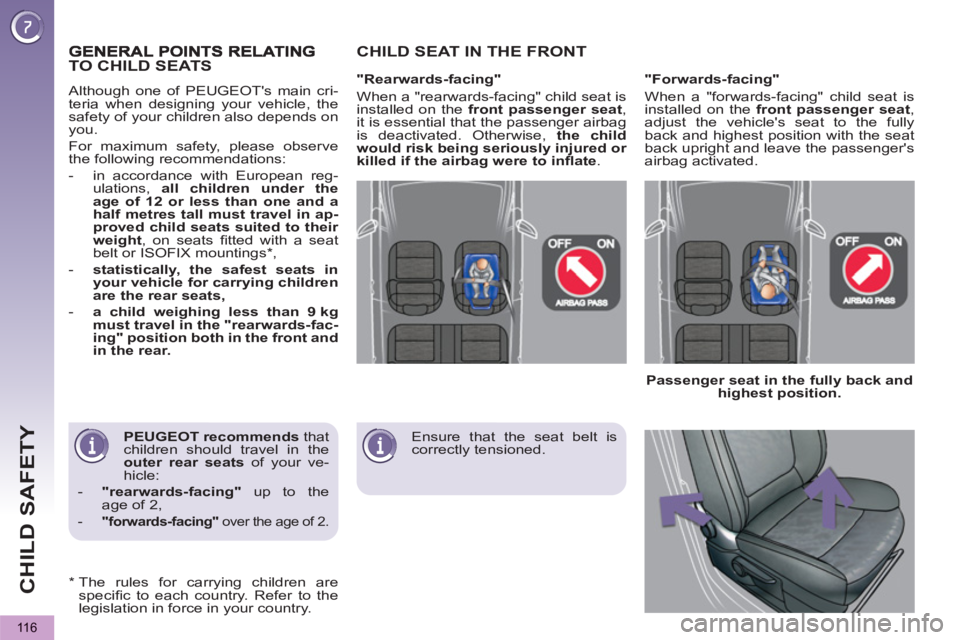
CHILD SAFETY
116
PEUGEOT recommends
that
children should travel in the
outer
rear seats
of your ve-
hicle:
- "rearwards-facing"
up to the
age of 2,
- "forwards-facing"
over the age of 2.
TO CHILD SEATS
Although one of PEUGEOT's main cri-
teria when designing your vehicle, the
safety of your children also depends on
you.
For maximum safety, please observe
the following recommendations:
- in accordance with European reg-
ulations, all children under the
age of 12 or less than one and a
half metres tall must travel in ap-
proved child seats suited to their
weight
, on seats fi tted with a seat
belt or ISOFIX mountings * ,
- statistically, the safest seats in
your vehicle for carrying children
are the rear seats,
- a child weighing less than 9 kg
must travel in the "rearwards-fac-
ing" position both in the front and
in the rear.
"Forwards-facing"
When a "forwards-facing" child seat is
installed on the front passenger seat
,
adjust the vehicle's seat to the fully
back and highest position with the seat
back upright and leave the passenger's
airbag activated.
"Rearwards-facing"
When a "rearwards-facing" child seat is
installed on the front passenger seat
,
it is essential that the passenger airbag
is deactivated. Otherwise, the child
would risk being seriously injured or
killed if the airbag were to infl ate
.
*
The rules for carrying children are
specifi c to each country. Refer to the
legislation in force in your country.
Passenger seat in the fully back and
highest position.
CHILD SEAT IN THE FRONT
Ensure that the seat belt is
correctly tensioned.
Page 119 of 340
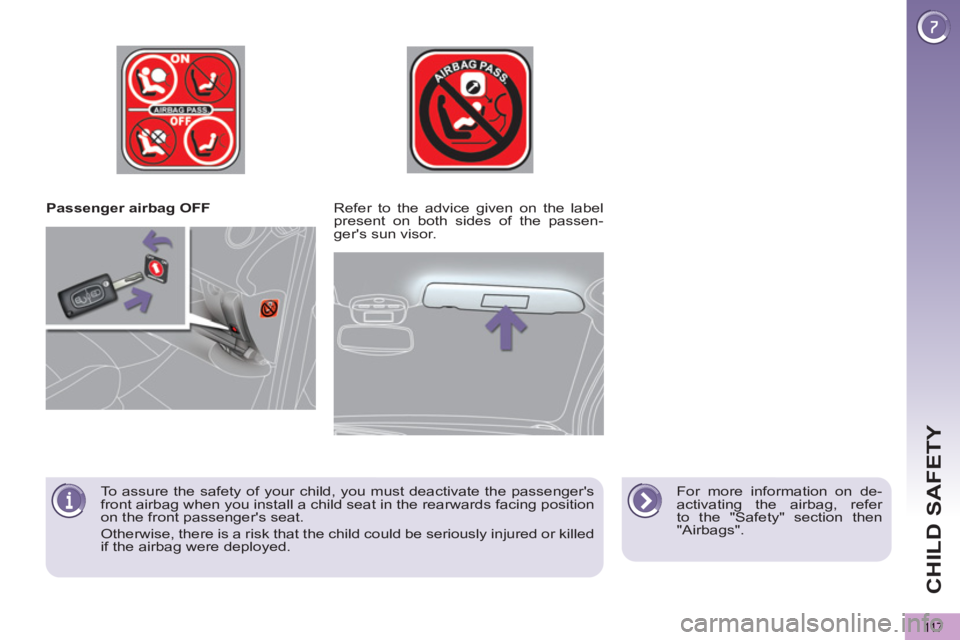
CHILD SAFETY
11 7
Passenger airbag OFF
For more information on de-
activating the airbag, refer
to the "Safety" section then
"Airbags".
Refer to the advice given on the label
present on both sides of the passen-
ger's sun visor.
To assure the safety of your child, you must deactivate the passenger's
front airbag when you install a child seat in the rearwards facing position
on the front passenger's seat.
Otherwise, there is a risk that the child could be seriously injured or killed
if the airbag were deployed.
Page 123 of 340
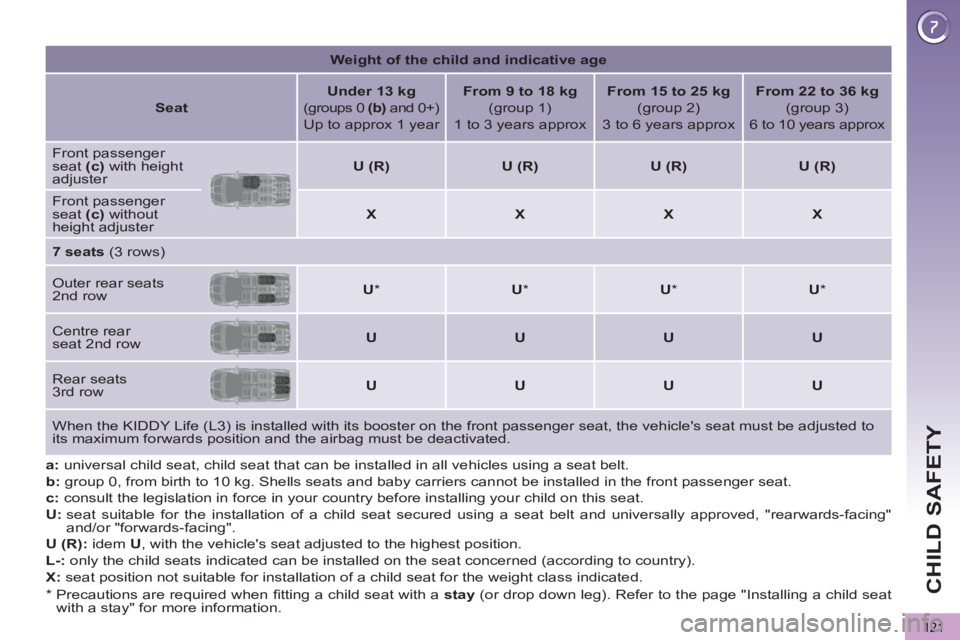
CHILD SAFETY
121
a:
universal child seat, child seat that can be installed in all vehicles using a seat belt.
b:
group 0, from birth to 10 kg. Shells seats and baby carriers cannot be installed in the front passenger seat.
c:
consult the legislation in force in your country before installing your child on this seat.
U:
seat suitable for the installation of a child seat secured using a seat belt and universally approved, "rearwards-facing"
and/or "forwards-facing".
U (R):
idem U
, with the vehicle's seat adjusted to the highest position.
L-:
only the child seats indicated can be installed on the seat concerned (according to country).
X:
seat position not suitable for installation of a child seat for the weight class indicated.
* Precautions are required when fi tting a child seat with a stay
(or drop down leg). Refer to the page "Installing a child seat
with a stay" for more information.
Weight of the child and indicative age
Seat
Under 13 kg
(groups 0 (b)
and 0+)
Up to approx 1 year
From 9 to 18 kg
(group 1)
1 to 3 years approx
From 15 to 25 kg
(group 2)
3 to 6 years approx
From 22 to 36 kg
(group 3)
6 to 10 years approx
Front passenger
seat (c)
with height
adjuster
U (R)
U (R)
U (R)
U (R)
Front passenger
seat (c)
without
height adjuster
X
X
X
X
7 seats
(3 rows)
Outer rear seats
2nd row
U
*
U
*
U
*
U
*
Centre rear
seat 2nd row
U
U
U
U
Rear seats
3rd row
U
U
U
U
When the KIDDY Life (L3) is installed with its booster on the front passenger seat, the vehicle's seat must be adjusted to
its maximum forwards position and the airbag must be deactivated.
Page 124 of 340
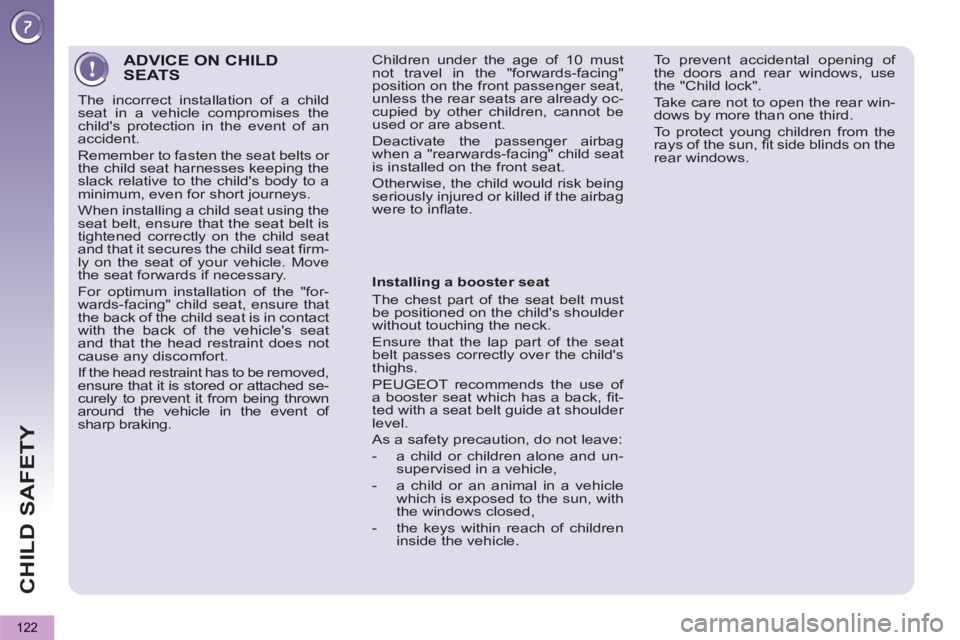
CHILD SAFETY
122
ADVICE ON CHILD SEATS
The incorrect installation of a child
seat in a vehicle compromises the
child's protection in the event of an
accident.
Remember to fasten the seat belts or
the child seat harnesses keeping the
slack relative to the child's body to a
minimum, even for short journeys.
When installing a child seat using the
seat belt, ensure that the seat belt is
tightened correctly on the child seat
and that it secures the child seat fi rm-
ly on the seat of your vehicle. Move
the seat forwards if necessary.
For optimum installation of the "for-
wards-facing" child seat, ensure that
the back of the child seat is in contact
with the back of the vehicle's seat
and that the head restraint does not
cause any discomfort.
If the head restraint has to be removed,
ensure that it is stored or attached se-
curely to prevent it from being thrown
around the vehicle in the event of
sharp braking.
Installing a booster seat
The chest part of the seat belt must
be positioned on the child's shoulder
without touching the neck.
Ensure that the lap part of the seat
belt passes correctly over the child's
thighs.
PEUGEOT recommends the use of
a booster seat which has a back, fi t-
ted with a seat belt guide at shoulder
level.
As a safety precaution, do not leave:
- a child or children alone and un-
supervised in a vehicle,
- a child or an animal in a vehicle
which is exposed to the sun, with
the windows closed,
- the keys within reach of children
inside the vehicle. To prevent accidental opening of
the doors and rear windows, use
the "Child lock".
Take care not to open the rear win-
dows by more than one third.
To protect young children from the
rays of the sun, fi t side blinds on the
rear windows.
Children under the age of 10 must
not travel in the "forwards-facing"
position on the front passenger seat,
unless the rear seats are already oc-
cupied by other children, cannot be
used or are absent.
Deactivate the passenger airbag
when a "rearwards-facing" child seat
is installed on the front seat.
Otherwise, the child would risk being
seriously injured or killed if the airbag
were to infl ate.